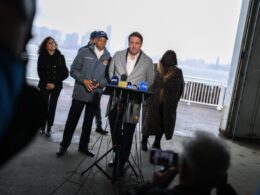A 28-person Task Force will soon vote on a master plan for the 122-acre Brooklyn Marine Terminal (BMT). This diverse group includes elected officials, residents, maritime and industrial organizations, and labor representatives who must make critical decisions about this historic waterfront. While we initially opposed transferring this property from the Port Authority to the city, now that the city owns BMT, it must repair the facility without conditions.
The Port Authority was created more than a century ago to build essential infrastructure projects through user fees from its assets without municipal tax dollars. By taking Red Hook and giving the PA the lucrative Howland Hook Marine Terminal on Staten Island, the city inherited a neglected facility without a funding plan. Now it’s asking residents to accept unprecedented luxury housing development to finance this acquisition.
Though Red Hook’s port is smaller than terminals in New Jersey and Staten Island, lacks direct rail connections to the Midwest, and has limited warehouse space, its major advantage is its location in the heart of America’s largest consumer market. While 95% of the port is in Newark Bay, two-thirds of regional residents live east of the Hudson River. With 520 miles of waterfront, maintaining Red Hook’s 1.5 miles ensures New Yorkers have direct access to ocean and barge shipping.
The Baltimore Key Bridge tragedy demonstrated how vulnerable supply chains can be — we need alternatives to maintain them under all circumstances. If the Kill Van Kull was blocked, our regional supply chain would face severe disruption, affecting millions of residents and thousands of businesses that depend on timely deliveries.
Since 1991, a “Blue Highway” barge service has connected Red Hook to vital supply chain nodes, carrying containers between Red Hook and Newark almost daily employing some of the industry’s most skilled longshore workers who represent generations of maritime expertise. This service keeps Red Hook active for vessels carrying fresh produce from Latin America and the Caribbean to grocery stores throughout the city and Long Island. Red Hook also handles lumber for building trades and prefabricated components.
The recently announced $18 million investment for a new container crane and removal of outdated equipment marks a good start, but more modernization is needed to handle more ships and barges that could eventually replace trucks, creating an environmentally sound regional transportation system that reduces congestion and pollution on our roadways.
To fund these upgrades, the city proposes developing thousands of market-rate apartments. Is this the best approach? Adding 8,000 mostly luxury housing units would create significant demands in an area already challenged by narrow streets, aging infrastructure, and limited transit options. By taking the property from the Port Authority, the city Economic Development Corp. forced an unfair burden on the community.
A unified vision is possible with real leadership. First, invest in port stabilization and improvements within the city’s budget, comparable to other public transportation investments like ferry lines, roads, and bridges that sustain our economy. New York State should also contribute, as BMT serves a larger region including Long Island and the Hudson Valley, where consumers receive fresh produce shipped to Red Hook.
We support addressing the city’s housing affordability crisis, but profound changes to this special neighborhood need careful consideration. Balancing port activity with residential and park uses requires further study without rushing to a vote through an artificial process. For 150 years, Red Hook has been an active working waterfront area, and EDC knew this when it accepted the property transfer.
We call on the city to prioritize port infrastructure improvements now, while deferring new housing to be later addressed through the city’s ULURP land use process. A state General Project Plan designed to limit local involvement is inappropriate for a decision where so many voices need to be heard.
ULURP was designed for complex land use decisions with maximum input from community members, multiple stakeholders, and local elected officials. Department of City Planning experts should be involved, as they have overseen changes to the Zoning Resolution in nearly every other major land use project. ULURP recently delivered the City of Yes, a consensus-driven plan addressing the housing crisis in areas with appropriate neighborhood context and transit.
We urge clarity: The Task Force should approve port improvements now and defer housing decisions for later though the ULURP Process.
Nadler, dean of the N.Y. congressional delegation, represented Red Hook piers for 30 years until redistricting and has been actively engaged in port and transportation issues. Genn was formerly senior vice president of the ports & transportation department at EDC.








